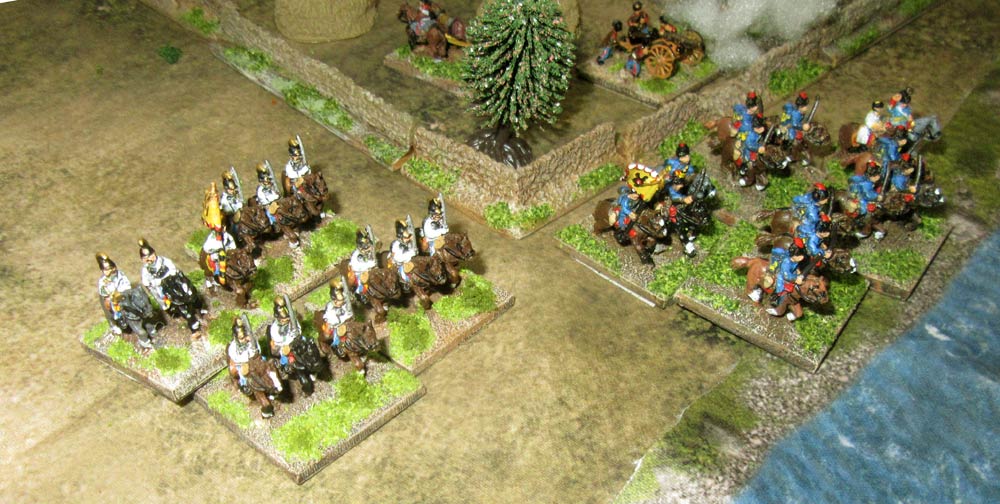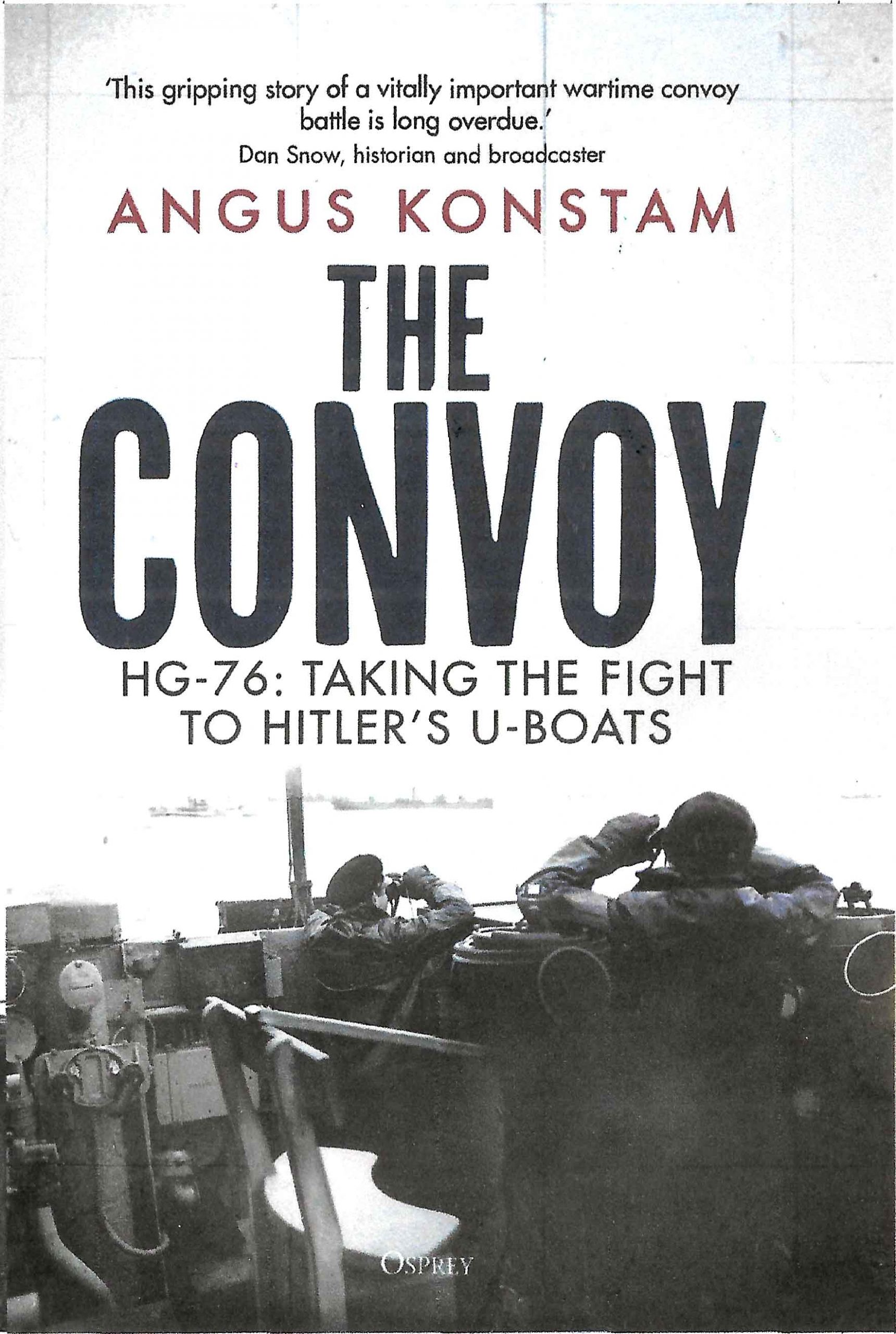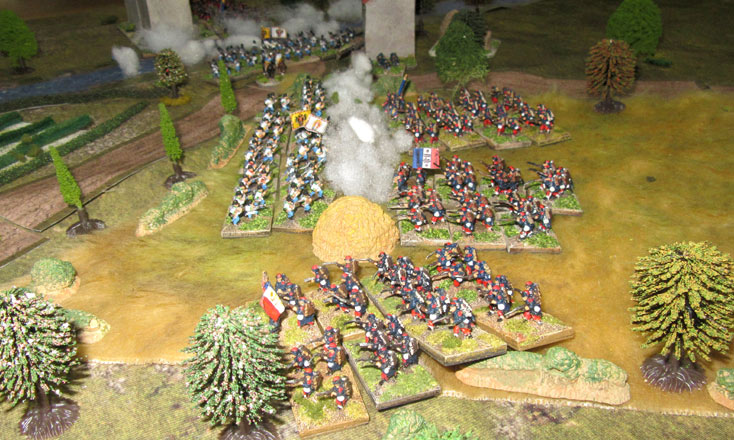
Bridgehead over the Olona, 1859
23rd October 2025, 0 Comments
Bismarck’s Wars, Brigade Fire & Fury, 10mm
With just Nick and I available for a game, I let him choose what we played. He opted for Bismarck’s Wars using Brigade Fire & Fury, but left it up to me to come up with the game. I opted for the Franco-Austrian War of 1859, a colourful alternative to 1866 and 1870 games. It was just a small divisional-sized game, but unusually it featured an Austrian attack – an attempt to seize a bridgehead over the River Olona, to the north of Milan.  In this fictitious game, Nick, commanding the Austrian VII Corps was attempting to secure a bridgehead over the river at Patabiago, between Legnano and Milan, to aid the retreat of the Austrian I Corps, which had been cut off following the French victory at Magenta. My French – part of Marshal Canrobert’s III Corps had to hold the line of the river, and foil the Austrian rescue attempt. That’s Nick above, at the east (long) edge of the 6×4 foot table.
In this fictitious game, Nick, commanding the Austrian VII Corps was attempting to secure a bridgehead over the river at Patabiago, between Legnano and Milan, to aid the retreat of the Austrian I Corps, which had been cut off following the French victory at Magenta. My French – part of Marshal Canrobert’s III Corps had to hold the line of the river, and foil the Austrian rescue attempt. That’s Nick above, at the east (long) edge of the 6×4 foot table. 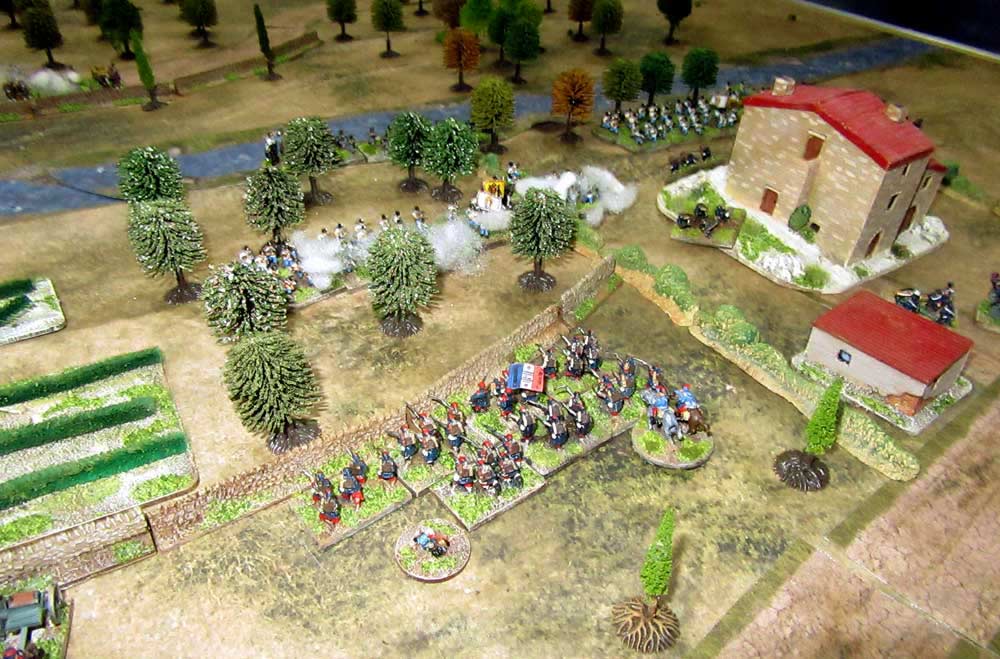 We both had a similar-sized force – the Austrian 2nd Division of Baron Zobel’s Corps was leading the attack, while Gen. Renault’s 1st Division of Canrobert’s III Corps was charged with holding the river line. The river was crossable for everyone but artillery – they had to use fords or bridges. Nick began by launching an assault on his left by Brigade Gablenz across the river to the south of Parabiago, near the hamlet of Nerviago.
We both had a similar-sized force – the Austrian 2nd Division of Baron Zobel’s Corps was leading the attack, while Gen. Renault’s 1st Division of Canrobert’s III Corps was charged with holding the river line. The river was crossable for everyone but artillery – they had to use fords or bridges. Nick began by launching an assault on his left by Brigade Gablenz across the river to the south of Parabiago, near the hamlet of Nerviago. 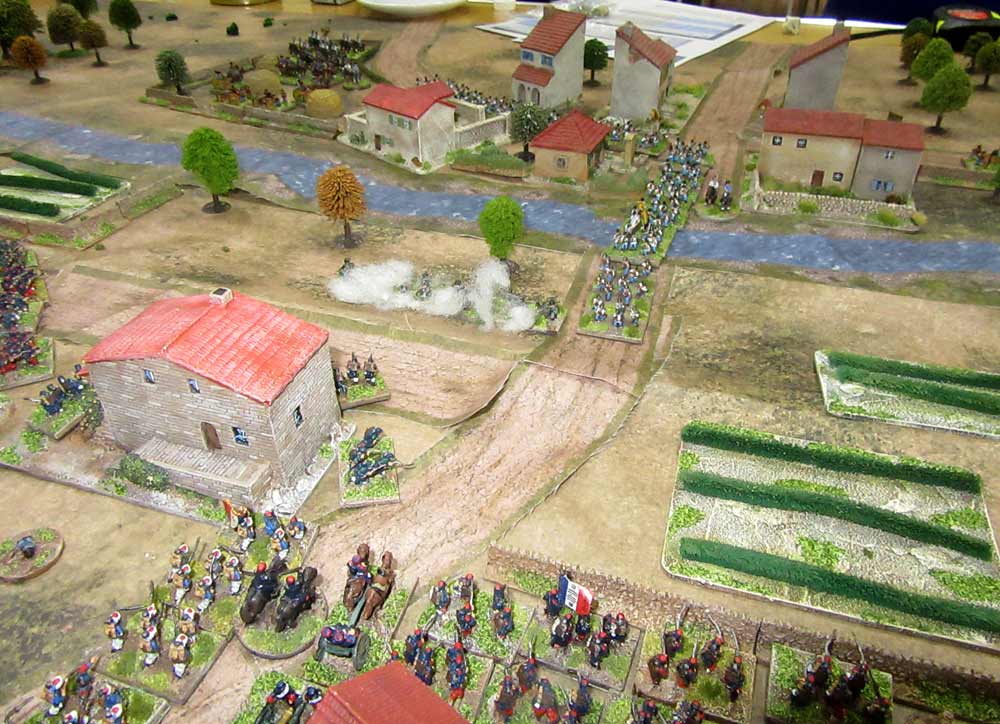 In Brigade Fire & Fury, an Austrian infantry regiment is 12 stands, while a French one was eight. Nick boosted this advantage by having the corps artillery support the river crossing. For my part, Jannin’s Brigade was battered by the guns, and couldn’t stop the Austrians from gaining a bridgehead. On the Austrian right though, Doens’ Brigade had an easy time of it – at first – as the Austrians lacked the artillery support of their colleagues.
In Brigade Fire & Fury, an Austrian infantry regiment is 12 stands, while a French one was eight. Nick boosted this advantage by having the corps artillery support the river crossing. For my part, Jannin’s Brigade was battered by the guns, and couldn’t stop the Austrians from gaining a bridgehead. On the Austrian right though, Doens’ Brigade had an easy time of it – at first – as the Austrians lacked the artillery support of their colleagues.  Still, the Austrian Brigade Lebzeltern pushed over the ford on the road from San Lorenzo across the river to Parbiago, with Inf. Regt. 1 Kaiser Joseph leading the way. Thanks to some excellent manoeuvre rolls, Nick was able to to deploy the regiment facing the town, while IR 22 Graf Wimpffen followed them across, and extended the bridgehead, supported by Jaegers. It was frustrating, but the Austrians now had their foothold across the river.
Still, the Austrian Brigade Lebzeltern pushed over the ford on the road from San Lorenzo across the river to Parbiago, with Inf. Regt. 1 Kaiser Joseph leading the way. Thanks to some excellent manoeuvre rolls, Nick was able to to deploy the regiment facing the town, while IR 22 Graf Wimpffen followed them across, and extended the bridgehead, supported by Jaegers. It was frustrating, but the Austrians now had their foothold across the river. 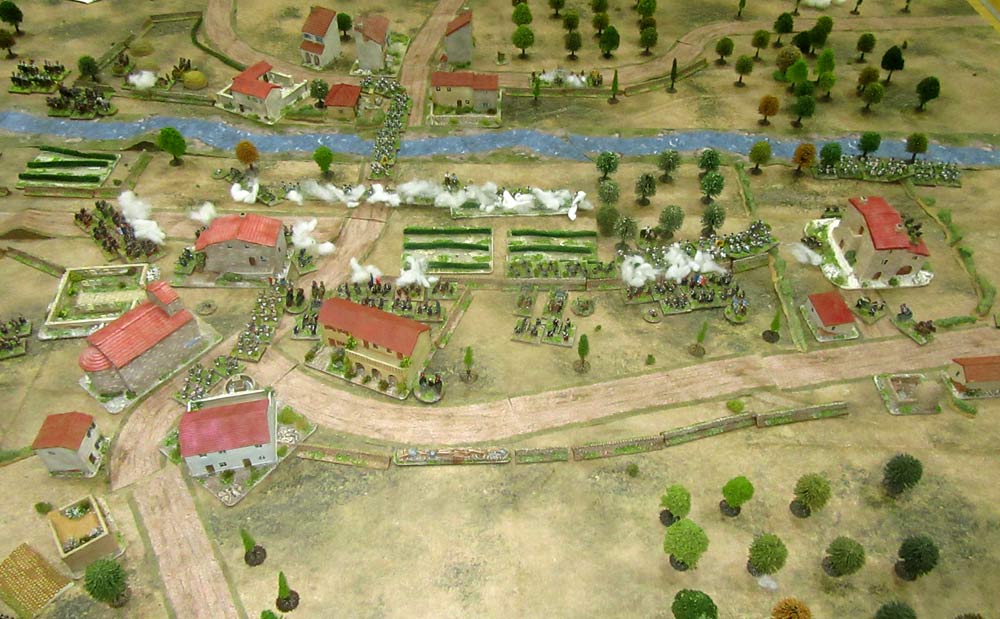 By now though, the fighting around Nerviago was hotting up. The Austrian IR 53 charged the French 41st Ligne, which was holding the line of a stone wall, and the Austrian assault was driven back. The Austrian orps artillery pounded the French chasseurs holding the farmhouse opposite the Austrian crossing point, but for the moment the farm stayed in French hands. However, a second Austrian regiment was now across, and preparing its own attack.
By now though, the fighting around Nerviago was hotting up. The Austrian IR 53 charged the French 41st Ligne, which was holding the line of a stone wall, and the Austrian assault was driven back. The Austrian orps artillery pounded the French chasseurs holding the farmhouse opposite the Austrian crossing point, but for the moment the farm stayed in French hands. However, a second Austrian regiment was now across, and preparing its own attack.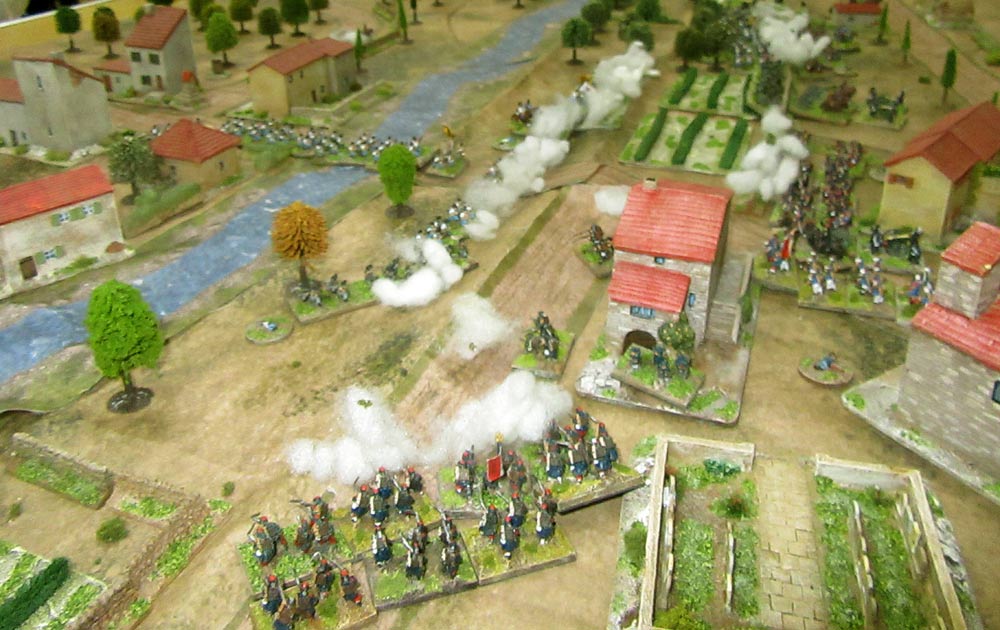 Over by Parbiago the Austrians tried to extend their bridgehead, but found themselves hemmed in by a resolute French defence by Doens’ Brigade. The 90th Ligne even charged the Austrian jaegers, only to be counter-attacked in their turn by Austrian cavalry, who’s splashed across the river to launch their attack. So, with the battle swinging to and fro almost every phase, the outcome of the battle there was completely up in the air.
Over by Parbiago the Austrians tried to extend their bridgehead, but found themselves hemmed in by a resolute French defence by Doens’ Brigade. The 90th Ligne even charged the Austrian jaegers, only to be counter-attacked in their turn by Austrian cavalry, who’s splashed across the river to launch their attack. So, with the battle swinging to and fro almost every phase, the outcome of the battle there was completely up in the air. 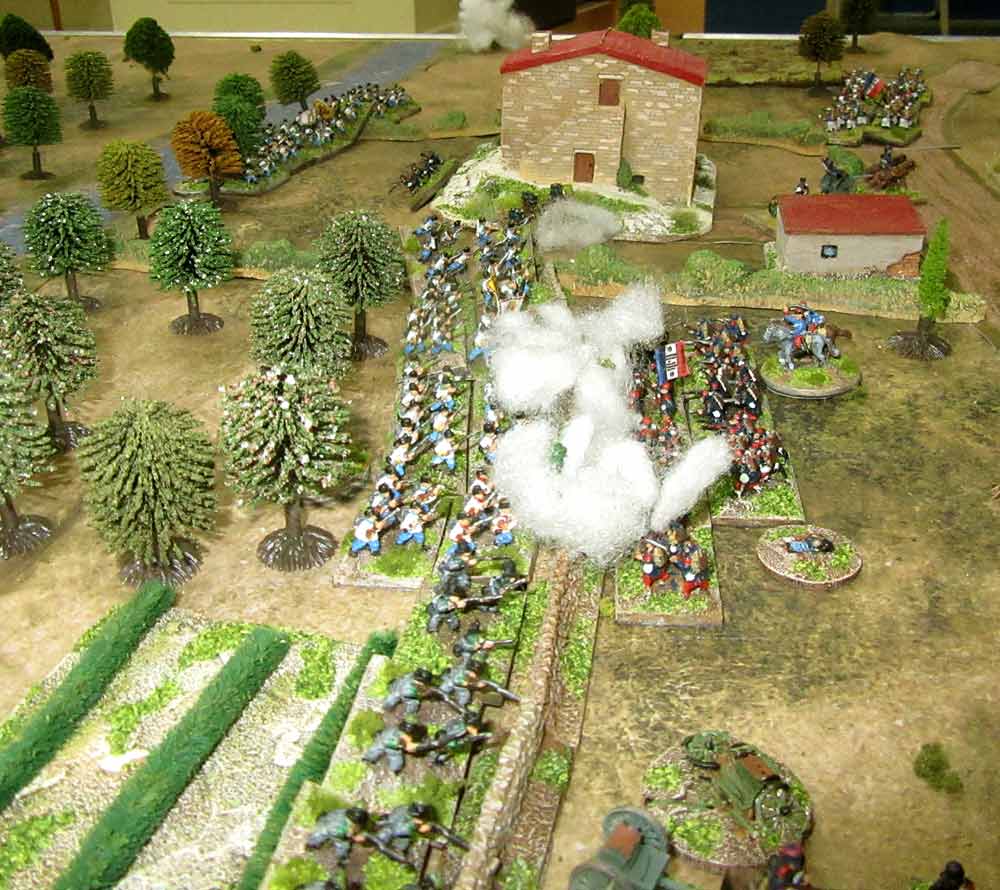 The Austrians though, had now managed to link up their two footholds in front of Parbiago and the Betulle farm, with jagers even firng at the French divisional artillery, forcing them to pull back. The outnumbered 41st Ligne though, still held their ground, as did the 8th Chasseurs holding the farm. the Austrians assault on the farm never came – a string of poor manouevre rolls saw to that. this then, bought time for the French to plan their own attack.
The Austrians though, had now managed to link up their two footholds in front of Parbiago and the Betulle farm, with jagers even firng at the French divisional artillery, forcing them to pull back. The outnumbered 41st Ligne though, still held their ground, as did the 8th Chasseurs holding the farm. the Austrians assault on the farm never came – a string of poor manouevre rolls saw to that. this then, bought time for the French to plan their own attack.  Supported by a brigade of French hussars the French 56th Ligne advanced on the Austrians lining the west bank of the river near the farm, and after a firefight the Austrian defenders were forced to retire. That eased pressure on the defenders of Betulle Farm, and gave the French defenders fresh heart.
Supported by a brigade of French hussars the French 56th Ligne advanced on the Austrians lining the west bank of the river near the farm, and after a firefight the Austrian defenders were forced to retire. That eased pressure on the defenders of Betulle Farm, and gave the French defenders fresh heart.  A little to the north the Austrians launched their long-awaited assault on Parbiago. The doughty IR 1 swept all before them, and pushed the French defenders of Doens’ Brigade back from the eastern outskirts of the town. Things were looking bleak fro the French for a bit, but the timely arrival of a fresh regiment helped stabilise the situation, especially as the French divisional guns were now back in action. So, the line still held – just.
A little to the north the Austrians launched their long-awaited assault on Parbiago. The doughty IR 1 swept all before them, and pushed the French defenders of Doens’ Brigade back from the eastern outskirts of the town. Things were looking bleak fro the French for a bit, but the timely arrival of a fresh regiment helped stabilise the situation, especially as the French divisional guns were now back in action. So, the line still held – just.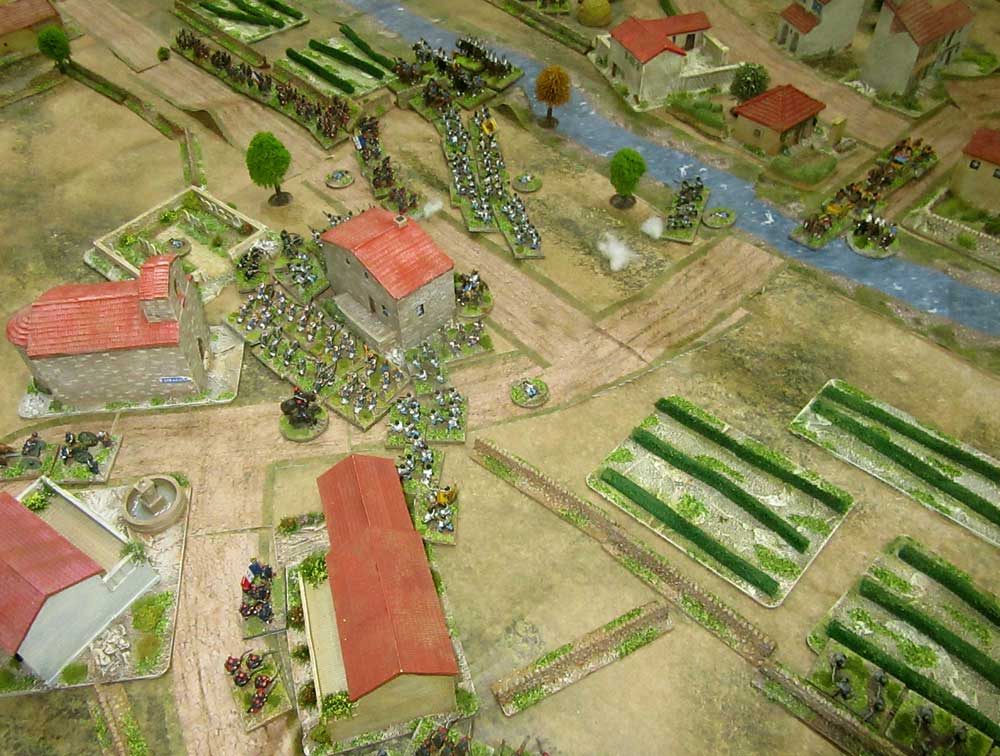 By now though, there was hand-to-hand fighting in Parbiago itself, but it seemed the French line was firming up again, and the ferocious Austrian assault was checked. One French regiment though, the 23rd Ligne was broken, leaving a worrying hole in the French defences – or it would if the Austrians had fresh troops to rush through the gap! Instead, with everyone worn down by the fighting, the battle degenerated into a bitter but static firefight.
By now though, there was hand-to-hand fighting in Parbiago itself, but it seemed the French line was firming up again, and the ferocious Austrian assault was checked. One French regiment though, the 23rd Ligne was broken, leaving a worrying hole in the French defences – or it would if the Austrians had fresh troops to rush through the gap! Instead, with everyone worn down by the fighting, the battle degenerated into a bitter but static firefight.  The fighting though, was down to the wire. A French battery pouring in point-blank grapeshot into the ranks of the Kaiser Franz Josef regiment proved a turning point of sorts, as it forced the Austrian spearhead to retire a bit – easing pressure on the battered French line. It was now clear that the battle had become a stalemate, with neither side able to deliver a knock-out blow. So, we ended the game there – and declared this lively battle an honourable draw!
The fighting though, was down to the wire. A French battery pouring in point-blank grapeshot into the ranks of the Kaiser Franz Josef regiment proved a turning point of sorts, as it forced the Austrian spearhead to retire a bit – easing pressure on the battered French line. It was now clear that the battle had become a stalemate, with neither side able to deliver a knock-out blow. So, we ended the game there – and declared this lively battle an honourable draw! 